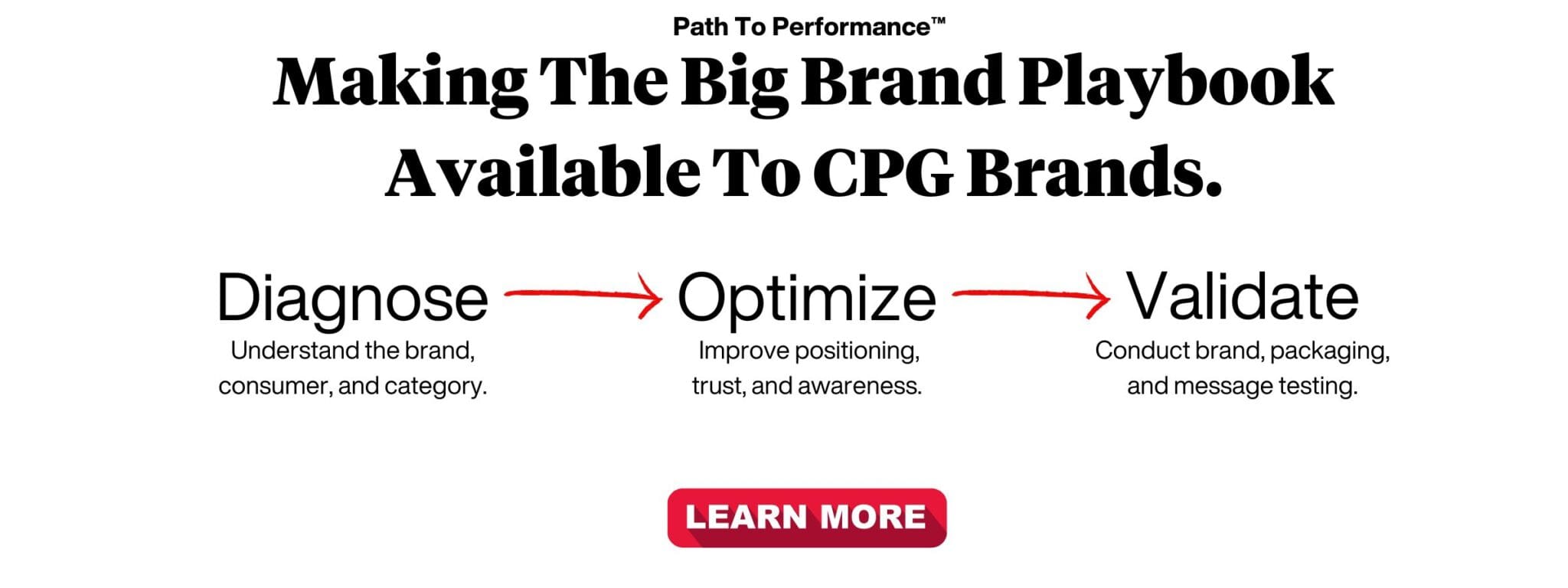Whether working with a new-to-market brand or an existing company undergoing a brand refresh, an audit process is necessary for brand development. The brand audit provides valuable insights into the following:
- The Brand
- Target Audience
- The Category
- Channel Opportunities
- Competitive Landscape
A comprehensive brand audit often separates strong brands that dominate a category from mediocre ones that struggle to remain on the shelf. But how do you perform an audit so that it takes your brand to the next level? That’s exactly what we will unpack in this article. Let’s get started.
What is a brand audit?

A brand audit is a systematic and thorough evaluation of a company’s brand to understand better its current state, performance, and effectiveness in the market. Brand auditing involves assessing various aspects of the brand, including its identity, positioning, messaging, communication, customer experience, and overall perception among its target audience and stakeholders.
Brand audits help companies identify strengths and weaknesses in their branding efforts. A comprehensive branding audit uncovers new growth opportunities and develops a brand strategy roadmap for improving and strengthening the brand’s overall performance and impact.
We often find that the brand audit definition includes other aspects of brand development that occur before the audit process. Let’s discuss those for a moment.
Preparing for a Brand Audit
Before you conduct a brand audit, you must ensure your efforts provide the insights you seek. In our Path To Performance™ process, we first perform discovery and assessments that enable us to audit the brand effectively.
Brand Discovery

The brand discovery process includes reviewing a company’s internal and external brand assets. Brand assets include social media content, marketing materials, existing reports, and previously acquired data. Collectively, we use this information to gain a deeper understanding of the brands:
- Brand Values: The values essential for the brand to uphold as it grows in the market.
- Company Mission: The “more important than the money” objective the company holds close to its hearts.
- Team Vision: Where the team wants the brand to go and what they hope to achieve in the coming years.
- Target Audience: The present-day customer persona most frequently engages with the brand.
- Competitive Landscape: Identifying the company’s unique selling proposition, brand purpose, key messaging, and brand personality, laying the foundation for effective brand development.
Brand Assessment

Evaluating a company’s brand performance and identifying areas for improvement. A brand assessment includes competitive assessments to:
- Analyze the company’s position in the market.
- Perform trend assessments to identify emerging opportunities.
- Analyze its brand identity, messaging, and customer experience to ensure consistency and relevance.
With these two steps completed, it’s time to determine the purpose and objectives of the brand audit. As a Brand development company, we must understand the brand’s expectations while bringing our ideas to the table before beginning brand audits.
Conducting a Brand Audit
Brand audits have three core areas that must be thoroughly analyzed. Collectively, they give insights into how to position a company precisely. For each branch of the brand audit, we are looking to identify the following:
- Brand Identity
- Brand Positioning
- Brand Distinction
- Brand Awareness
- Brand Perception
- Brand Equity
- Brand Loyalty
- Brand Value
Keep these branding components in mind as you walk through each aspect of a brand audit.
Competitive Audit

A competitive assessment looks at the brand’s competitors and determines them collectively and isolatedly. The assessment thoroughly reviews the competitor brand’s packaging design, website, store placement, social media campaigns, and other marketing efforts.
Sales Channel Audit

A retail audit looks at the store itself to get insights on how to stand out. Looking at the existing and prospective sales channels is necessary to see the competitive landscape and how products are placed on the shelf. A sales channel audit
Brand Design Audit

A design audit looks at the packaging itself. It identifies what’s working and what isn’t. The Brand design audit identifies any distinctive assets a brand can use to reach the target audience in their particular category. A brand design audit includes all current brand elements to the forefront to see what is worth retaining as we introduce a new design to the target market.
Analyzing the Results
The next step in the brand audit checklist is to make sense of the audit. A brand management team or brand development firm will analyze the current brand’s strengths and where they see possibilities for improvement.
A qualified brand manager or brand strategy agency can take the results and find actionable insights for immediate brand improvement. However, before making any changes to the current brand, testing essential changes are necessary to protect or enhance brand perception.
Insight: Prioritize the insights discovered in the branding audit putting what is most important upfront. The audit’s outcome may result in more insights than can be applied now.
Developing a Brand Strategy
After thoroughly reviewing the brand audit, the next step is creating your brand strategy. You will outline the efforts to improve the brand’s future performance here. The action plan will include the following steps.
Setting Measurable Goals and Objectives
While you might be eager to jump right into it and start making changes to the brand, it’s vital that you first create measurable goals and clear objectives. Many methods exist to set achievable goals, but most strategies include setting smart goals.
Smart goals are specific, measurable, achievable, relevant, and time-bound outcomes. In the case of a brand audit, they must align with the brand’s mission, vision, and company values. Ensure the goals are clear, concise, and effectively communicated to your team.
Identifying Specific Branding Strategies
The brand audit has helped you understand the destination, but what is the best path for reaching it? Now is the time to outline the strategies you can use to achieve your brand goals. You must identify the strategy with the most significant impact and that you are most likely to execute successfully.
Then it’s time to lean on your team, decides who will “own” these strategies, and be responsible for seeing them to fruition.
Perform Brand Testing
A forgotten step by many brands is to test each strategy to determine its impact on the brand. CPG Brand testing can include everything from the logo to the packaging design. While many brands understand the need for split testing their marketing efforts, only a small percentage perform testing as part of their branding strategy.

Establishing Performance Metrics
The action plan must establish a clear timeline for monitoring the strategies put in place due to the brand audit. Establishing performance metrics keeps the team aligned with the goals and objectives previously set.
Here are a few performance metrics a brand should measure.
- Marketing strategy: Is our approach to marketing continuing to grow our external branding?
- Impact on target customers: Are consumers recognizing our perceived brand value, and are we achieving greater customer loyalty?
- Consistency in brand voice: From sales to social media, is the brand voice maintaining the same tone?
Establishing performance metrics is one of the most underappreciated topics when someone asks how to do a brand audit.
Monitoring the Brand Strategy
Determining what we will track is important, but only if we actively and accurately monitor the action plan. Here’s how to do it right.
Communicating the action plan
When it comes to team communication, leave no stone unturned. While the janitorial department may not need to understand the improved brand direction, those outside your brand development team should. Everyone from the leadership team to customer service should understand what branding strategies are in place to grow the company.
Start by communicating in a one-to-many format, shifting into company departments, and finally, as one-on-one discussions.
Tracking Outcomes
While brand testing can closely predict the impact of each change made in the audit, monitoring the changes over time is essential. Continuously gauging the success of these changes ensures the team upholds them and identifies small nuances that can better impact your optimized branding, marketing, and packaging strategy.
Set a time to track these changes and assign the right team members to this task.
Analyzing Brand Audit Reports
Reporting on the results and impact of the brand audit is the final step in the process. It is vital to evaluate the effect of the brand audit against the objectives set at the beginning of the process. All decision-makers should meet to discuss the comprehensive reports highlighting the successes, challenges, and key takeaways.
Preparing For Future Brand Audits
Consumers change, channels change, and so does the market. To assume any aspect of a branding audit is permanent would be a big mistake. As a CPG brand strategy agency, it is our job to perform an audit concerning the category and economic changes, but nothing lasts forever.
Recognizing this truth keeps your finger on the pulse. By maintaining awareness, you can acknowledge the need for another audit (a year or two) before any “what happened” events occur.
Data-Driven Brand Development
Want a best-selling brand? SmashBrand is a brand development agency for FMCG and CPG companies. From brand strategy to packaging design testing, our Path To Performance™ process guarantees a retail performance lift. Book a time to discuss your project with our team.
Frequently Asked Questions
How Often Should A Brand Conduct An Audit?
There is no fixed timeframe for conducting a brand audit, as it depends on factors such as industry changes, market trends, and company growth. However, we recommend companies conduct a branding audit every two to three years. But this may come sooner when there is a significant change in the company’s business model, target audience, or marketing strategies. Regular brand audits ensure that companies stay relevant and competitive in the marketplace and help them identify new growth opportunities and areas for improvement.
What Is A Branding Audit?
A branding audit is a comprehensive evaluation of a company’s brand to assess its current state, performance, and effectiveness in the market. A branding agency will audit various aspects of the company, such as its identity, positioning, messaging, communication, customer experience, and overall perception among its target audience and stakeholders. A branding audit aims to identify a brand’s strengths and weaknesses, uncover growth opportunities, and develop a brand strategy roadmap.
What Is A Brand Voice Audit?
A brand voice audit evaluates a company’s brand messaging to ensure consistency and effectiveness across all communication channels. It involves analyzing various aspects of the brand’s voice, such as tone, language, style, and messaging, to ensure they align with its values, personality, and target audience. A brand voice audit aims to strengthen its messaging, improve its communication strategy, and enhance the customer experience.
What is a Brand Audit Template?
A brand audit template is a structured document that provides a framework for conducting a brand audit. It typically includes questions, criteria, and metrics to evaluate various aspects of the brand and helps ensure the audit process is comprehensive, consistent, and objective.
Subscribe to
Nice Package.
A monthly newsletter that unpacks a critical topic in the FMCG & CPG industry.
Free Resource.

CPG product repositioning guide.
Explore the five undeniable signs your CPG product needs repositioning along with strategies for leveraging consumer insights for a guaranteed market lift.
Learn More About CPG product repositioning guide.

